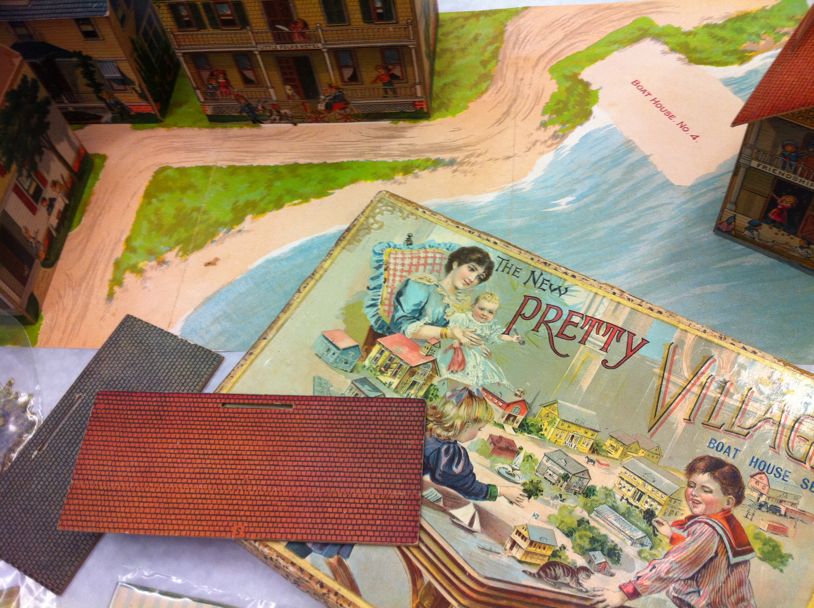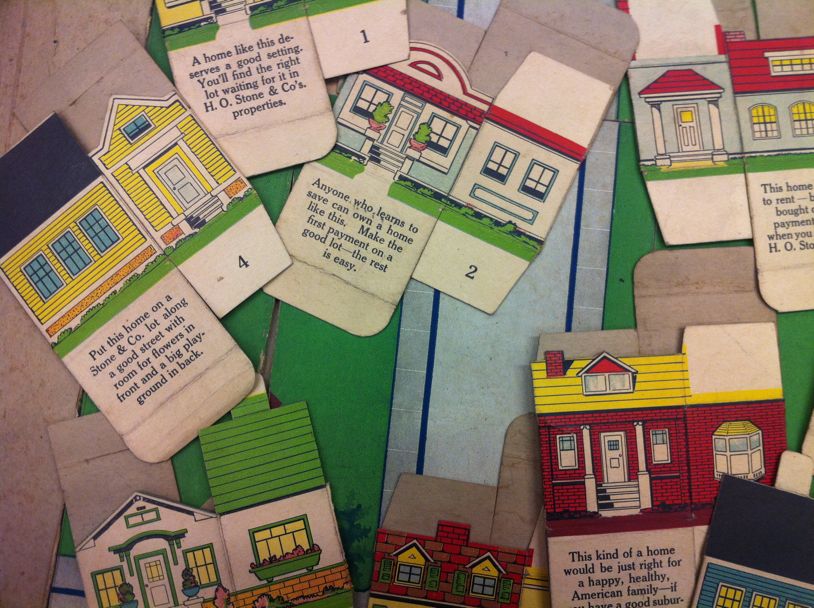
Can a building toy help homebuyers make better decisions about the style, location & financing of their house while teaching children how to be better community planners?
Apparently H.O. Stone and Company, a prominent real estate developer in Chicago from the mid-19th to mid 20th century, thought so. Manufactured in 1928, their Model Home City is one of the more obscure and remarkable building toys in the National Building Museum’s collection. Exemplary largely because it was created not by one of Chicago’s many toy manufacturers but by a real estate developer, at first glance the toy is not particularly unique.
Pretty Village, 1897 Paper and cardboard McLoughlin Brothers, New York
There are a number of building toys in the Museum’s collection such as the McLoughlin Brothers’ Pretty Village, that likewise consist of a collection of colorful cardboard houses, a fold-out plan and an opportunity to replicate an ideal semi-urban/suburban community. H.O. Stone’s Model Home City is exemplary and different because it is not just a toy, but also a teaching and marketing tool, aimed at both children and adults.
Model Home City, 1928 Paper and cardboard McLoughlin Brothers, New York
The game teaches the value of good city planning, tests your ability to pick the best location and shows how the building of fine homes enhances the desirability of adjacent homesites.
On the underside of each house is a lesson for the kids or parents who are attempting to create their ideal community. Some of these are planning tips, providing helpful suggestions about the siting of your house, the impact of your design choices on the value of your neighbors’ houses, and how to layout the surrounding landscaping features. Promoting H.O. Stone’s home building and property sales, some of the tips are pure, unabashed marketing. However, others take a softer tone, providing helpful tips on saving money and home ownership.
Although the Model Home City is entirely unique as a planning toy, there are a few precedents for building toys inscribing various types of lessons on the pieces of the toy. Most notable are the church building toys of the late 19th and early 20th century that incorporated scripture on the building blocks for educational purposes but also represented a savvy move by toy makers to convince parents to let their children play on Sundays.
Why is all of this exciting? ‘Making’ is an extremely important and central part of the way I design with others– it truly does allow great things to happen. In many of these situations, various types of prompts, questions or challenges are necessary to tap into the very best of people’s ideas and capabilities. At times, either from a group management or ownership stand point it can be incredibly productive if those prompts don’t explicitly come from me. Integrating them into the making process, into the models themselves as H.O. Stone and Company have done, offers a much more discovery oriented, seamless way of building and exploring possibility.
Alex Gilliam, the Director of Public Workshop, is currently the Field Fellow at the National Building Museum in Washington, D.C. and is conducting research in its extensive Architectural Toy Collection. The opinions expressed in this article are his own. All included images are courtesy of the National Building Museum. To use or obtain copies of these images, or if you have any other questions about the collection, please contact: research@nbm.org .



Posted on January 20th, 2011 at 7:36 pm by publicworkshop in News, Writing